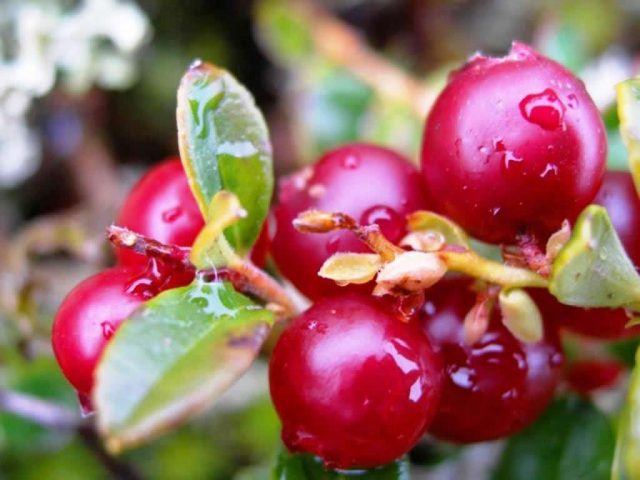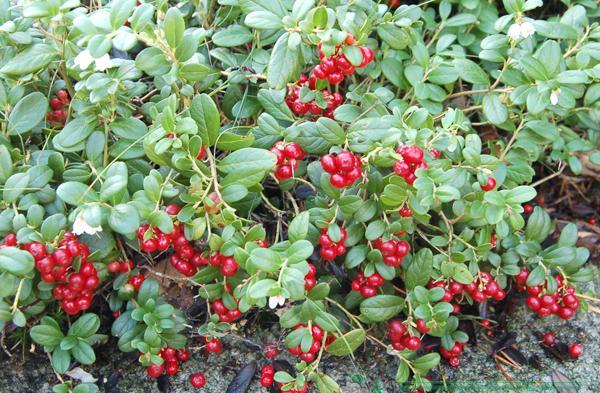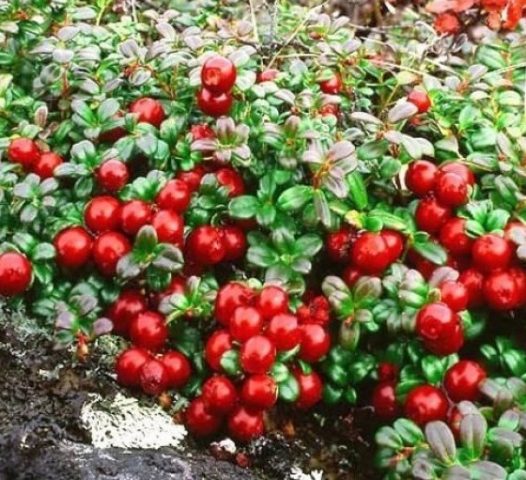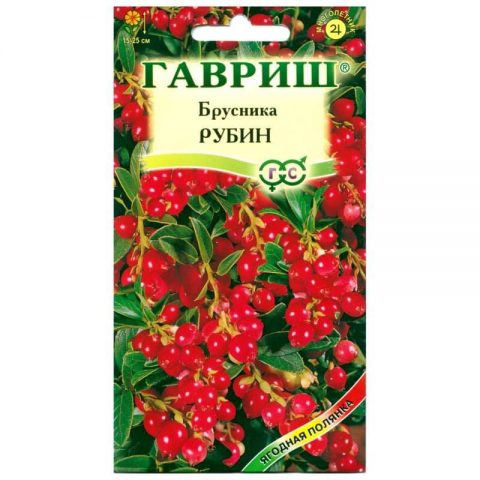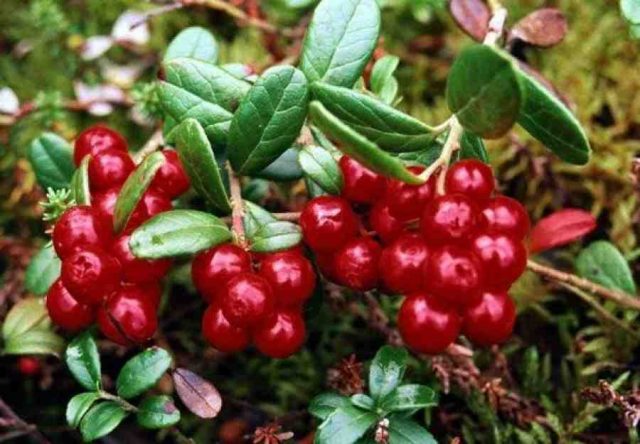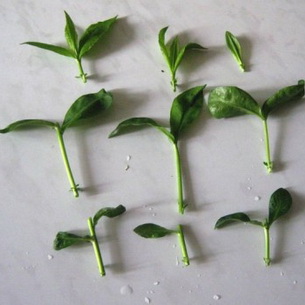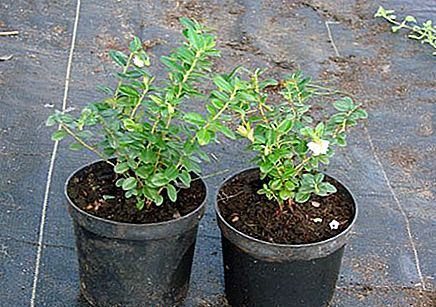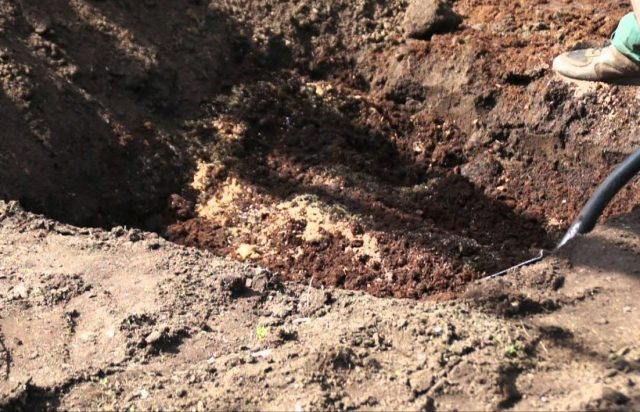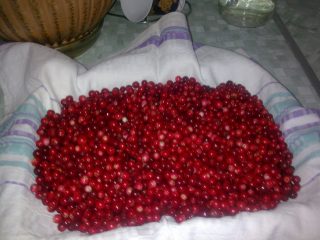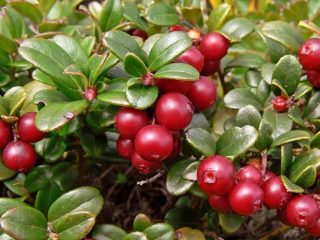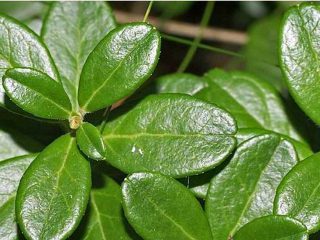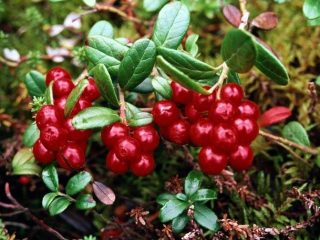Content
- 1 Brief description of lingonberries
- 2 Is it possible to grow lingonberries in a garden plot?
- 3 Varieties of garden lingonberries
- 4 How do garden lingonberries reproduce?
- 5 Growing lingonberries from seeds at home
- 6 Planting and caring for lingonberries in open ground
- 7 Diseases of garden lingonberry
- 8 Conclusion
- 9 Reviews
In the minds of most people, lingonberries are associated with taiga forests and forest-tundra expanses, which are covered with fields of beautiful and healing berries. But it turns out that there are also garden lingonberries, which are quite capable of settling in a personal plot and becoming its decoration, while simultaneously bringing health benefits.
Brief description of lingonberries
Lingonberries were widely used by distant ancestors.It is not for nothing that its name comes from the Old Slavic word “brusvyany”, which means red and hints at the bright colors of its berries.
Lingonberry is an evergreen shrub, reaching a height of no more than 30 cm. Evergreen dark shiny oval leaves up to 2-3 cm long are its main decoration in the cold season. On the bottom of the leaves you can see resin glands in the form of black dots. At the end of spring, small bell-shaped flowers of a pale pink hue appear at the ends of last year's stems. They don't smell strong, but they smell nice.
Under the ground there are actually lingonberry roots, rhizomes and underground shoots, with the help of which plants can conquer additional living spaces. The system of rhizomatous and underground shoots is located in the upper layer of the earth, no deeper than 15-20 cm.
The seeds are small, reddish-brown in color and shaped like a crescent.
What type of fruit is lingonberry?
The fruits of lingonberry are round, shiny red berries. That is, from a botanical point of view, these are multi-seeded fruits that consist of a fleshy pericarp and a thin upper layer (skin). They can reach 8-10 mm in diameter, and about 0.5 g in weight.
The taste of lingonberries is tart, sweet and sour, with a slight bitterness. In nature, the fruits ripen from mid-August to the end of September. They can spend the winter under snow and in the spring they crumble at the slightest touch.
One berry contains from 5 to 30 seeds.
Lingonberry yield per season
In the wild, the yield of lingonberries is insignificant - only about 100 g of berries can be harvested from one square meter.
Even when wild shrubs are transferred to cultivated conditions, their yield can increase several times.The first forms of garden lingonberries were already capable of producing 700-800 g of berries per square meter of land. But over time, it turned out that some varieties of garden lingonberries can bear fruit twice per season, and thereby increase the total yield for the season to 2 kg/sq. m.
Compliance with the specifics of planting and caring for lingonberries described in the article will allow you to get even more than 2 kg of berries from the plants per 1 square meter. m.
Is it possible to grow lingonberries in a garden plot?
It was the significant increase in yield when trying to grow garden lingonberry in cultivation that forced breeders to come to grips with developing its garden forms.
Back in the middle of the last century, almost simultaneously, Swedish, German, Dutch and American breeders took up this process. At the moment, there are already more than 20 varieties of garden lingonberries, which differ not only in their significant yields, but also in the larger size of the berries and the height of the cultivated bushes.
At the same time, the requirements for planting and care for wild and garden lingonberries are almost identical.
- Lingonberries can grow well and bear fruit only in acidic and well-drained soils with a minimum organic content.
- Humidity conditions in the root zone should correspond to the “golden mean”. If it is too dry, especially at high air temperatures, the lingonberry bushes will die. On the other hand, with constant waterlogging of the soil, they will also die, primarily from a lack of oxygen exchange in the soil.
- Garden lingonberries adapt quite easily to any air temperature. But in extreme heat, it will require more abundant and regular watering, and the berries may still become smaller.
- Neither garden nor wild lingonberries are afraid of frost; they tolerate temperatures down to -40 °C in winter. The only thing is that its flowers can suffer from frosts in late spring or early autumn (they cannot tolerate temperatures below - 4 ° C).
- Lingonberries love good light, and in partial shade the yield will decrease and the berries will become smaller.
- Under no circumstances should lingonberry bushes be overfed - under natural conditions they grow on very poor soil.
Varieties of garden lingonberries
As mentioned earlier, foreign breeders have been especially active in breeding forms of garden lingonberries in the last 50-70 years. But in Russia, three varieties of garden lingonberries are currently registered in the State Register of Breeding Achievements:
- Kostroma pink;
- Ruby;
- Kostromichka.
Although these varieties are inferior to imported ones in yield, height of bushes and size of berries, they take root and feel themselves in Russian conditions, according to gardeners, sometimes better than their foreign counterparts.
Description of lingonberry Belyavskoe fleece
The garden lingonberry variety was bred by Polish breeders in 1996. It forms low, but compact and dense spherical bushes, reaching 20-25 cm in height and width. It is characterized by early ripening: from mid-August to early September. The berries are quite large, oval in shape, ranging in size from 9.5 to 11 mm. They have a sour but mild taste.
The variety is also distinguished by its self-fertility and high yield (up to 300-350 g per bush). Tolerates frosts well.
Judging by the reviews, the lingonberry variety Belyavskoye Fleece is in demand among gardeners, primarily due to its frost resistance, high yield and attractive taste.
Coral
This variety, originally from the Netherlands, is considered the very first garden form of lingonberry obtained in cultivation. It was registered back in 1969. Despite its rather advanced age, Coral is still popular due to its high productivity and decorative value.
Its berries are not the largest (up to 0.9 cm in diameter), but a lot of them ripen. In addition, the bushes are remontant, that is, they can produce 2 harvests per year. The first harvest is small, it ripens in late July or early August. The second harvest produces the largest number of berries in late September or early October. In total, one bush can produce up to 400 g or more berries per season.
The bushes are distinguished by erect shoots more than 30 cm long. Daughter rosettes are poorly formed.
Red Pearl
Another Dutch variety of garden lingonberry, registered already in 1981. The berries are large in size, up to 12 mm in length. And the bushes themselves and the leaves are relatively large in size. It is also capable of producing two crops per season, but the yield is slightly lower than that of Coral.
Sanna
This variety of garden lingonberry was bred in Sweden, in the province of Småland in 1988. Its distinctive feature is the intensive formation of daughter rosettes on underground shoots. Thanks to this, soon after planting one plant, a whole carpet of lingonberries can form in the garden bed. The berries are quite large, round in shape, reach 0.4 g in weight, and ripen in mid-August. From one bush you can get 300-400 g of lingonberries.This is the most productive variety of Swedish garden forms.
Kostroma pink
This Russian variety of garden lingonberry is characterized by the largest berries. Their diameter reaches 10 mm, and some weigh up to 1.2 g.
The bushes are small in height - up to 15 cm. They are self-fertile and early ripening, ripening in mid-August. The yield of lingonberries varies depending on growing conditions from 800 g to 2.6 kg per square meter.
Ruby
Considered the most promising lingonberry variety of garden Russian selection, it is capable of bearing fruit twice a year. True, in the conditions of the Kostroma region this does not always work out due to early autumn frosts. It was obtained, like all other Russian lingonberry varieties, in 1995. The berries are medium in size, reaching 0.6 g. The yield, therefore, is up to 2.9 kg/sq. m. per season. The bushes are low - up to 18-20 cm.
Underground shoots are actively formed by children, so the variety can be used as a ground cover plant. Ruby is classified as a self-sterile variety, therefore, it requires the obligatory presence of insects (bumblebees) on the site.
Kostromichka
The Russian variety of garden lingonberry, Kostromichka, is also distinguished by its low bushes. Its advantage is its early ripeness; the berries ripen in the first half of August. They are medium in size (diameter about 8 mm, weight about 0.3-0.5 g). However, the yield can be up to 2.4 kg/sq. m.
Garden lingonberry varieties for the Moscow region
In the conditions of the Moscow region, almost any variety of garden lingonberry should have enough heat and light to not only grow and bear fruit well, but also produce two harvests per season, if it has the potential to do so.
In addition to those described above, the following varieties of garden lingonberries can be planted in the Moscow region:
- Erythcrone, a variety from Germany that is capable of producing two harvests per season.
- Eritzegen, also a German variety, distinguished by its especially large (more than 1 cm) and sweet-tasting berries.
- Ammerland, Another German variety of garden lingonberry, forming tall spherical single bushes, 30 cm in diameter. It is distinguished by a fairly high yield (up to 300 g per bush) and double fruiting.
The remaining known varieties are not distinguished by such high yields, but can be quite used for decorative purposes.
How do garden lingonberries reproduce?
Lingonberries can quite easily propagate generatively (by seeds) and vegetatively (by green and woody cuttings, underground rhizomes and children).
Seed method
Under natural conditions, young lingonberry plants, hatched from seeds, appear around June-July. At home, sprouts can begin to develop in the spring.
In general, propagation by seeds allows you to obtain a considerable number of seedlings ready for planting almost free of charge, especially since lingonberry seedlings are very expensive (about 500 rubles with a closed root system). In addition, seeds usually produce plants that are stronger and more adapted to specific growing conditions.
But this method of reproduction also has disadvantages:
- Bushes grown from seeds can wait at least 4-5 years to bear fruit.
- This activity is quite labor-intensive and the first two years the seedlings require constant attention and can die due to any oversight.
- Plants grown from seeds do not retain the characteristics of their variety, so anything can grow from them.
Propagation of lingonberries by cuttings
Both green and woody cuttings of garden lingonberries are suitable for propagation.
Green cuttings are usually harvested in mid-July, while woody cuttings are harvested at the end of March, in April - during the period of swelling of the buds.
After cutting and before planting, they can be stored in moist sphagnum moss at a temperature of 0 to + 5 ° C.
It is best to root cuttings in greenhouse conditions in loose and acidic peat-sandy soil. The length of the cuttings should be from 5 to 8 cm.
The lower leaves are torn off, leaving only the upper 2-3 buds, which are located above the surface of the soil. The rest of the cutting, pre-treated with Kornevin or another stimulant, is placed in the ground.
The top of the cuttings should be covered with film on the arches and additionally insulated with non-woven material if the weather is cold.
Roots may appear within 3-4 weeks, but final rooting occurs within several months. The soil must be kept moist at all times and the plants must be sprayed periodically. By autumn, the bed with cuttings is covered with a layer of mulch and again insulated with covering material.
Next year, in the spring, the rooted cuttings can be transplanted into pots or into a special bed for growing.
Depending on the care conditions, the rooting rate of such cuttings can range from 50 to 85%. The first fruits may appear on them in 2-3 years.
Since quite a lot of cuttings can be cut, and the resulting bushes retain all the properties of the mother plants, this method of propagation is more popular among gardeners.
Propagation by rhizomes
In exactly the same way, you can take cuttings in early spring from underground shoots or rhizomes of garden lingonberries. They are cut 10-15 cm long so that each has at least one bud or shoot rudiment. Plant the cuttings to a depth of about 10 cm in loose and acidic soil. Otherwise, caring for the resulting bushes is the same as described above. The rooting percentage is usually around 70-80%.
Reproduction by layering
Since some varieties of garden lingonberries have an increased ability to form children, this is often used for propagating bushes. You can get up to 10 cuttings from one plant. You can also separate the babies in early spring or autumn. In the first case, they are traditionally planted on a seed bed and by autumn they form full-fledged plants. During the autumn separation, the children are placed in pots and left to winter in a frost-free room. The survival rate of seedlings with this method of propagation is usually 85-100%.
Therefore, propagation by layering is the most reliable way to propagate lingonberries. But you won’t be able to get many seedlings this way.
Growing lingonberries from seeds at home
If you decide to grow garden lingonberries from seeds, then the easiest and most reliable way to do this is at home.
Recommended sowing dates
Garden lingonberry seeds are able to actively germinate only after stratification. Since stratification usually takes 4 months, it must be started in advance, in November-December. At this time, the seeds selected from the fruits are washed and mixed with wet sand. The container with the seeds is placed in a refrigerator or other cold place where the temperature is constantly maintained at about + 4 °C.
Sowing begins after four months, that is, approximately in March or April.
Preparing soil and containers
For sowing garden crops, you can use any plastic or ceramic containers. Their volume depends on the number of seeds sown. Typically, half-liter or larger containers are used.
The ideal composition for germinating lingonberry seeds:
- 3 parts sphagnum peat;
- 2 parts sand;
- 1 part perlite.
Drainage (expanded clay, fine gravel) is usually placed at the bottom of the containers in a layer of about 1 cm, then the prepared soil is poured and watered with snow or rainwater to compact it.
How to plant lingonberries correctly
The most important feature of lingonberry seed propagation is that its seeds germinate only in the light. Therefore, under no circumstances should they be sprinkled with soil on top.
- Typically, grooves are made in the prepared and slightly compacted soil mixture, several millimeters deep.
- Lingonberry seeds are poured into the grooves.
- The container is covered with polyethylene on top and placed in a well-lit place with a temperature of about + 20 °C.
- The film is periodically lifted to ventilate and check the soil moisture.
- If necessary, moisten the soil.
- The first shoots may appear on days 12-15, but the appearance of the rest may well take 4 weeks.
- After a month, the film can be finally removed.
Rules for growing lingonberries at home
When lingonberry seedlings form 4-5 leaves, it is advisable to plant them in boxes, maintaining a distance of 5 cm from each other.
In the first months, young lingonberry plants need a lot of light and relatively little heat. They should not be placed in a room that is too warm. The ideal temperature would be from + 15 °C to + 20 °C.
Humidity should also be moderate, but it is not advisable to let the soil dry out.
Already in the first season they can begin to branch. It is best to keep young lingonberry plants for the entire first year of life in a box at home, without planting them in open ground. And only in the second season can the seedlings be carefully transplanted into a seedling bed prepared in advance. Or you can plant them in separate containers that will overwinter in a greenhouse.
Only in the third year of life is it recommended to plant lingonberry seedlings in a permanent place of growth.
Planting and caring for lingonberries in open ground
In order for garden lingonberries to please not only with good growth, but also with abundant harvests, it is necessary to pay attention to all its care requirements. Moreover, the plant is not particularly capricious. There are only basic nuances that must be taken into account when communicating with this culture.
Recommended planting times
You can plant lingonberry bushes in both spring and autumn. But planting lingonberries in the fall carries the risk that plants that are not sufficiently prepared for winter may simply die. Therefore, in the autumn, only fully mature seedlings are usually planted, preferably with a closed root system, without violating the integrity of the earthen ball.
Most gardeners recommend planting berries in the spring. Depending on the weather conditions of the region, this can be done starting in mid to late April, or in May.
Site selection and soil preparation
When choosing a suitable place for planting lingonberries, it is necessary, first of all, to take into account its illumination. After all, with shading, the bushes increase their growing area and leaf mass, but the yield inevitably decreases.
The terrain should be as smooth and horizontal as possible. So that lingonberries are not planted in depressions where water can stagnate. On the other hand, the source for irrigation should also be located nearby in order to uninterruptedly supply the bushes with the necessary moisture.
Wind protection is desirable. You can use the walls of buildings or rows of planted trees for these purposes.
Garden lingonberries are not so picky about the choice of soil; they can grow even on almost bare rocks. The most important thing for it is good drainage, ensuring a constant flow of oxygen to the roots and an acidic reaction of the soil environment. Therefore, it will not feel well on black soils and heavy loams. Sandy soils are best suited for growing lingonberries in the garden.
If garden lingonberries are to be grown in fairly large volumes, then the soil for them must be plowed and completely rid of perennial rhizomes. weed. It is best to do this a year before planting. On heavy soils it will be necessary to add a significant amount of sand. But lingonberries will grow well only if the soil acidity does not exceed 4-5.
It’s easiest for those whose lingonberry plantings will take only a few square meters. In this case, garden lingonberries can be grown on any soil by creating special soil for it.
- To do this, remove the top layer of soil about 25 cm thick in a fenced area and remove all weed rhizomes mechanically.
- Then the vacated area is filled with a mixture of high-moor peat, sand, pine litter, sawdust and part of the forest litter from the coniferous forest.
- Then the surface of the resulting soil is sprinkled with sulfur, in an amount of about 50 g per 1 square meter. m.
- Finally, the soil is compacted and a layer of sand about 4-5 cm thick is poured on top.
- The prepared area is watered with acidified water, based on the calculation - per 1 square. m. of land use 10 liters of liquid.
If you wish, you can also add a set of mineral fertilizers in the following quantities:
- 20 g of saltpeter;
- 40 g double superphosphate;
- 20 g of potassium sulfate per 1 sq. m.
When planting garden lingonberries, you should not use organic fertilizers (manure, humus, compost) or those containing chlorine.
How to plant lingonberries in the country
The density of placement of lingonberry seedlings in the prepared area is determined, first of all, by the varietal characteristics of the plants. Varieties prone to producing children should be planted a little more spaciously.
On average, the distance between bushes in a row should be left 25-30 cm, and between rows - 30-40 cm.
Plants are planted, slightly deeper (1-1.5 cm) into the soil, compared to how they grew in the previous place. The area is immediately watered and mulched with a layer of sawdust, pine bark, nut shells or sand, 3-5 cm high.
In the first two weeks after planting lingonberries on a summer cottage, watering should be regular (daily in the absence of rain).
Growing lingonberries on a personal plot
Watering is a very important procedure for caring for growing garden lingonberries.It is advisable to carry out drip irrigation so that in dry and hot weather, watering is carried out at least twice a week. For 1 sq. m. it is necessary to consume about 10 liters of water.
Several times a season, you can water with acidified water to maintain the required level of acidity in the soil. For this, it is most advisable to use a solution of battery electrolyte (50 ml of solution per 10 liters of water).
As for fertilizing, it makes sense to use fertilizers for the first time only in the second year after planting lingonberries in the ground. And here the basic rule should apply - it is better to underfeed than to overdo it in this direction.
Of the fertilizers, sulfuric acid forms are most suitable; you can also use superphosphate in an amount of 5 g per 1 square meter. m.
The next feeding with complex mineral fertilizer is carried out only when the lingonberries begin to bear fruit abundantly.
Weed control is very important when caring for lingonberries. In addition to their mechanical removal and periodic loosening of the soil, it is important to constantly maintain the required thickness of the mulch layer around the lingonberry bushes (from 3-4 cm). It serves to maintain the required level of humidity, to protect against frost in winter, to control weeds and to additionally feed plants.
On purely peat soils, it is best to mulch the plantings with sand. In other cases it will help:
- sawdust;
- pine litter;
- crushed bark;
- shavings;
- gravel;
- nutshell;
- chopped straw.
In the Moscow region, planting and caring for lingonberries is completely standard. But special attention should be paid to the danger of frost in late spring and early autumn.Because of them, the ovaries and flowers can be damaged and, accordingly, part of the harvest is lost.
To protect the bushes, they can be covered with various insulating materials: spunbond, spruce branches, straw, film. Or use smoke bombs on the eve of frost.
In order not to reduce the productivity of garden lingonberry bushes, they need pruning and thinning, starting from about 6-8 years of age.
Anti-aging pruning is carried out by cutting off the tops of the bushes in early spring (before the juices begin to flow) and leaving about 5-7 leaves at a height of 5-6 cm. After pruning, lingonberries should be fed with complex fertilizer in small doses. Fruiting after pruning will resume only next year, but after a few years it may even exceed previous yield figures.
To carry out gentle pruning, only about 1/3 of the branches are cut out from the middle of the bushes or only 1/3 of the bush is cut in height.
Since many of the garden lingonberry varieties are self-sterile, it is necessary to actively attract pollinating insects to the site and protect them: bees and bumblebees.
Diseases of garden lingonberry
Garden lingonberries are rarely damaged by pests or diseases. Among the insects it can be bothered by leaf rollers and heather leaf beetle. For preventive purposes, it is necessary to treat plants with an insecticide, for example, fitoverm, in early spring.
Diseases may include rust and late blight. Preventive treatments with phytosporin, alirin and gamair can help.
Conclusion
Garden lingonberry is a plant that has been known for a long time, but is relatively new for growing under cultural conditions, which, nevertheless, can successfully fit into and decorate the appearance of any garden plot.

